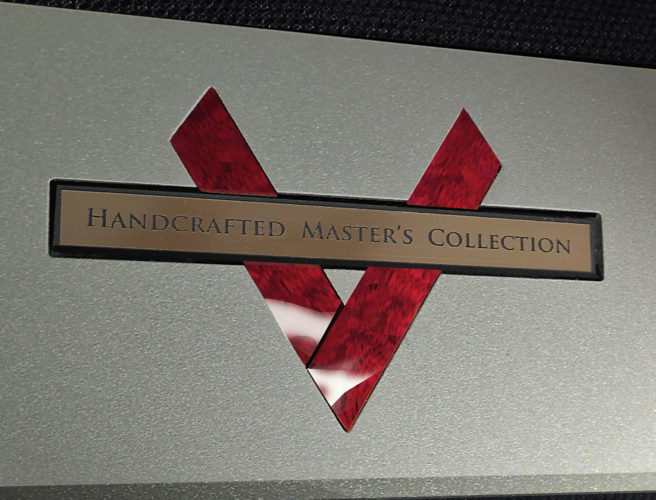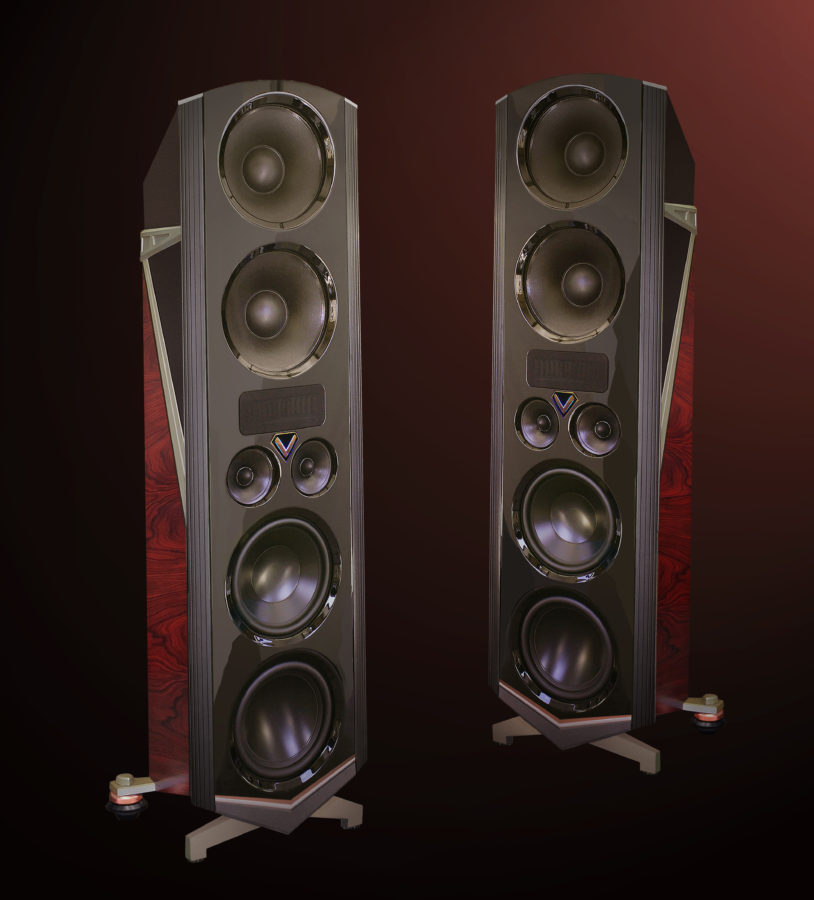Introduction: This review is massive, the longest I have written, eclipsing the article I wrote seven years ago about the Legacy Audio Helix speaker. The first half of this review will contain much technical information on the extreme performance of the V Speaker System in its entirety, while the second half will focus on tuning the system, introducing detailed discussion of the Wavelet DAC/Preamp/Crossover, the Bohmer Audio Acoustic Processing software and remarks about listening experiences.
VESUVIUS
Two million people live in the shadow of the strato-volcano Vesuvius, and they desperately hope there’s never another Pompeii and Herculaneum eruption. The last time I flew into Quito, the capitol of Ecuador, Cotopaxi, one of 25 volcanoes in the country, was belching steam and ash that was thankfully wafting away from the airport. The first time you see an active volcano doing its thing 30 miles away it makes you think!
Let us consider extreme speakers as volcanoes having explosive performance. Speaker systems have markedly different performance thresholds, far more than the average audiophile realizes. When someone on a forum posts that their system sporting 40” tall 3-way speakers having a single 8” or 10” woofer per channel does state of the art sound they are ignorant about the extent of the continuum of performance for speakers. There are very few volcanic speakers that have explosive, tremendously exciting, overwhelming performance. Such speakers are well known to enthusiasts, garnish awards as being state of the art, and are often the focus of discussion at shows.
One speaker manufacturer that can make monumental transducers, Legacy Audio, created the Double Helix, an industrial grade high-end speaker for public installations such as IMAX theaters. The Double Helix is capable of fantastic output and yet has such controlled directivity that it can be used in a room as small as 16’ x 24’! Those dimensions are not too far off from my room at 13’ x 23’. The speaker in the spotlight here, the Legacy V, does not have mountainous performance, it has volcanic performance. I submit that the volcano analogy breaks down in terms of precision, but as we shall see when the Legacy Audio V erupts it is all about highly dynamic directivity, power sculpted with precision.
Right out of the box (crate, gate…) the V erupted in the best performance I have heard from any speaker in my room regardless of design, and things only got better from there. Pause to absorb that comment; the V bettered all other speaker systems even when it was not optimized, when the Wavelet DAC/Preamp/Crossover integral to it had not been tuned to taste and the Bohmer room correction software had not been engaged. The speaker started out dominant and increased its supremacy with time.
VARIEGATED
There is a lot going on at Legacy Audio. A glance at the online catalogue shows the company is deep into both domestic and pro audio. Quietly, Legacy’s President, founder and chief designer Bill Dudleston’s designs have made their way into very high places in the music industry. Witness the warm reception of Legacy by Antonio L.A. Reid, Epic Records CEO and Grammy-winning producer, who proclaimed a McIntosh sound system with Legacy speakers, “My Best Investment.” Observe Peoria, Illinois’ 3-D Giant Screen Theater at the Riverfront Museum, outfitted with no less than five of the enormous Double Helix speakers for the front of this monstrous sound system. The Pro Spotlight page on Legacy’s website discussing this system reads, “It provides up to 20 steerable sound locations powered by 42 channels of amplification delivering 14,000 watts.”
This is not kid’s stuff. Legacy is kicking butt, shipping a large quantity of big, expensive HiFi speakers overseas. I saw evidence of this last year while on a trip to Singapore, where I stopped in at TriTone AV and met MD (CEO) Mervyn Augustine Loh, a most pleasant and enthusiastic man. The store was one of many audio shops crammed into four levels of a “Lifestyle Mall”. However, the vast majority of them carried speakers half the size of the Aeris, which I had a chance to hear while there. TriTone had already sold 16 pair of Aeris, remarkable in a culture where space is at a premium. Mervin was hopeful that one day he would showcase the V. It makes a strong statement about the value of a Legacy Audio speaker when customers in Singapore will foot the approximately $5,000 charge for shipping the Aeris versus buying a more expensive competitor. It was an honor that I happened to be visiting Legacy’s dealership of the year.
Seven years ago I had the pleasure of reviewing the flagship Helix. As impressive as the speaker was, looking back we see that the Helix was a product in development. At the time the processor used with the Helix, the Wavelet, was utilitarian and not terribly user-friendly. A significant barrier still stood between the pro-world sensibility of the Helix and the typical audiophile listening room.
There has been a steady push by Legacy to move speaker systems toward the Pro end of audio and, at the same time, to make these systems more palatable to people with no interest in the nuts and bolts of active speaker systems, most evidently seen in an entirely new Wavelet DAC/Preamp/Crossover, a subject of intense scrutiny in Part 2 of this review. Seven years ago I felt like a voice crying in the wilderness, “Prepare the way for Legacy!” I sensed the echoes of my voice bouncing off the walls of the industry. That didn’t trouble me terribly as I continued to review and own Legacy speakers, including the Focus, Focus SE, Whisper and ultimately the tricked out Whisper DSW Clarity Edition, a design that allows the speaker to be used actively or passively. Now I detect there are many ears listening.
One discerns the DNA of the Helix and the Whisper in the V, but the line has become variegated, new thoughts from Bill taking form. Legacy now offers 24 distinct designs – and that is in reference only to their speakers for the home. Chalk up another 23 designs for Professional audio. How many speaker companies do you know offering 47 designs? That should tell you something about the depth of experience and the reception of Legacy Audio among the domestic and pro audio industries.
Those two worlds, pro and domestic, are being drawn together by Legacy. The award winning Aeris, Whisper XD and Focus XD did not exist seven years ago. The Whisper and Focus existed at the time, but not the “X”, or active, versions of them. Legacy’s line for the home is increasingly incorporating more pro audio sensibility as time goes on. And it’s about time!
VIRTUOSO
Bill Dudleston is no stranger to those in the audio industry. The Legacy website hints at the impact Bill is having when it mentions that he “…has designed and provided Legacy speaker monitors for Arista, Sony, Universal Music Group and archival organizations such as the Stradivari Violin Society.” In 2016, Legacy fulfilled a big order for Sony. What other company do you know of providing reference speaker systems to Sony? Legacy speakers have also been used in re-mastering by Steve Hoffman for re-issues of Elvis Presley, Frank Sinatra and Nat King Cole.
The scope of understanding at Legacy Audio is broad and the capacity to apply the knowledge base is extensive. Is all that mental firepower necessary? Surely a $50K speaker is nothing more than a money grab, an inflated concept of good sound to lighten the wallets of the gullible. After all, anyone can build a speaker in their garage; you just put together the necessary elements of crossover, drivers, wiring, binding posts, footers (if desired) and likely damping material in a cabinet and you get a speaker. Follow someone’s pattern who has worked out the compatibility of the elements and surely you will come up with a winner. I hope you see that I am being facetious; superior speakers are not the result of cookie cutter assembly but, rather, fanatical number crunching and assessment followed by over-the-top parts procurement and assembly. If you think Legacy’s commitment to active processing of the signal is unwarranted, consider Bill’s explanation to the question of whether a processor operating in milliseconds is significant enough to warrant attention:
“I would explain an error between two drivers of only one-half millisecond at 1kHz will introduce a 180 degree phase error and create an acoustic power dip 18dB deep while moving an apparent image from front and center to well outside the speakers. Timing accuracy is so key to the stereo process that any improvement is to the benefit of the listener.
Passive crossovers introduce power losses and reduce driver damping. They also require physical set-back of drivers to align in time which only works at a single point in space. They are very sensitive to driver impedances and are century old technology. DSP provides precise control of crossover slopes and their frequency corners.”
Could you develop a processor and speaker that can operate in that realm in your garage? The point is clear: higher standards of sound reproduction have developed extensively from the days of passive speakers and are now migrating toward more advanced, and yes, sometimes much more costly active systems.
When I was going to review the Whisper, which at the time was a speaker requiring an active crossover and six channels of amplification, it presented me with a quandary. Imagine as a reviewer having to request three stereo amps from an amp manufacturer, or triple sets of speaker cables from a cable designer to use with the Whisper. If the Whisper was going to be used extensively it had to be easier to accommodate.
In discussion with Doug Brown, Legacy’s Vice President, I floated an idea; what if the speaker could be made to operate in different modes, actively and passively? Perhaps it could be made to be used with one stereo amp and tri-wired, or alternatively used with the full outboard complement of six channels of amplification. The thought struck me that it could shrewdly be called a “crossover speaker.” It could, and Doug made sure Bill heard about it. Since then that unique pair of Whisper speakers has been precious for reviews because of that flexibility, as well as having undergone the “Clarity Edition” upgrade wherein the entire speaker was rewired with 10 gauge Clarity Cable, and Bill added Clarity Caps (no relation to Clarity Cables) for the passive crossover. One industry member who has heard it wants it because that very design would be extremely helpful for his team’s development of their components. Things will keep getting better for Legacy enthusiasts because the new version of the Wavelet for the V and Aeris will find its way to the Whisper as well.
However, I need to confess something; as much as I have loved the Whisper DSW Clarity Edition, it’s no longer my first love. From the moment I heard the V in my room I felt my allegiance shifting, my passion waning from the Whisper sitting right outside the listening room, and waxing for the V sitting before me. The execution of the concepts implemented in the V outshines the Whisper by quite a bit. The V is simply, as enthusiasts are wont to say, in a different class. Just as there is a leap from mass produced performance sedans to closed circuit racing cars, there is a leap from the performance of the Whisper to the V. Whisper didn’t give away my allegiance, the V has taken it away through overwhelming dominance.
- (Page 1 of 4)
- Next page →

